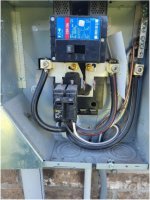The scenario: the service to a residence is a 200A meter combo (200A main breaker, lugs and 2 blades of each phase for breaker) there is an existing 2-pole, 40A breaker in the meter combo, the interior main panel is fed off the lugs. The interior main panel does not have a main breaker.
I want to tap the conductors feeding the interior main panel with 50A of solar. The length of tap conductors is less than 5 ft. I have a 60A fusible disconnect with 50A fuses prior to the point of interconnection.
My co-worker suggests derating the main in the meter combo to 175A to accommodate the tap. If that is necessary, why not just breaker back-feed the PV on the bus in the meter combo.
Is it necessary to derate the breaker, whether we're tapping the conductors or breaker back-feeding?
I want to tap the conductors feeding the interior main panel with 50A of solar. The length of tap conductors is less than 5 ft. I have a 60A fusible disconnect with 50A fuses prior to the point of interconnection.
My co-worker suggests derating the main in the meter combo to 175A to accommodate the tap. If that is necessary, why not just breaker back-feed the PV on the bus in the meter combo.
Is it necessary to derate the breaker, whether we're tapping the conductors or breaker back-feeding?


